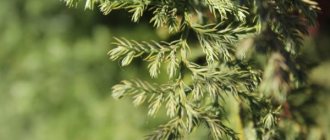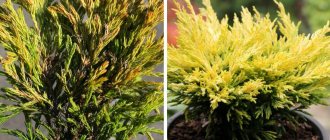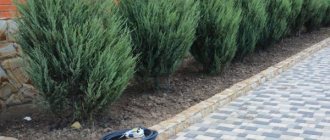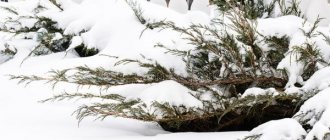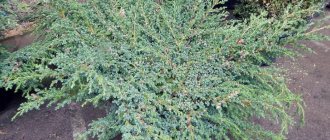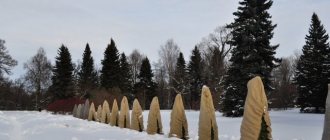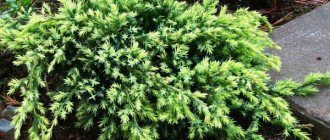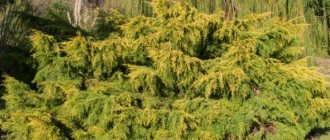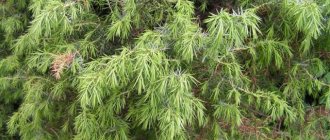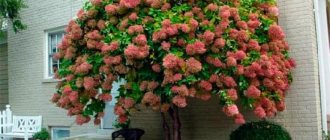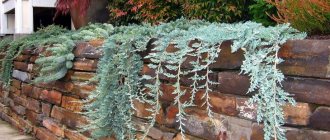Bushes and trees
0
383
Article rating
Kira Stoletova
The newly bred Meyeri juniper is one of the most unpretentious plants with beautiful blue needles. This variety, native to the mountainous regions of China and other East Asian countries, has been very popular in landscape design for more than 10 years.
Juniper Meieri: how to grow in the country
Brief information about the variety
- Color : the needles are prickly, bright green, the needles darken with age.
- Height : 60-70 cm.
- Crown diameter : 3-3.5 m.
- Growing regions : the plant has poor frost resistance, so without shelter it can be grown in the southern zone. In colder areas, good winter insulation will be required.
- Planting features : 1.5x2 m, suitable for a sunny place with slight shade.
- Immunity : resistance against diseases is high.
- Life expectancy : no information found.
Juniper: cultivation and care (video)
In addition, juniper can be affected by diseases of coniferous species, which are provoked by parasitic fungi. In this case, the needles acquire a brown tint. Black spots form on the branches. Juniper needs to be treated with sulfur and copper-containing products. Dried and diseased branches must be removed to prevent the spread of fungus.
It is very rare to find small mosquitoes and gall midges on junipers. They lay bright yellow larvae for the winter. They need to be controlled with insecticides.
general characteristics
Common juniper Meyer belongs to the Cypress family (full name juniperus squamata meyeri compacta).
The plant does not need fertile soil, frequent watering and nutrition. In its natural environment, it adapted to strong winds, drought and acquired a squat shape.
The description includes several features:
- ephedra reaches 60-70 cm in height at maturity;
- the shoots are spreading, densely covered with needles;
- the crown diameter of an adult tree is 3-3.5 m;
- the needles are prickly, bright green, greenish-gray, with age the color becomes dark green;
Over the course of a year, the plant forms young growth from 10 to 12 cm long, the tips of the branches have an intense bluish tint.
Growing regions
The evergreen coniferous plant has poor frost resistance, so it can be grown without shelter in the southern zone of the country.
In regions with cool and changeable weather (in the Moscow region, Leningrad region, in the North, in Central and Middle latitudes) good insulation for the winter will be required.
What types and varieties of juniper are used in landscape design - names with photos
Not all types of juniper have decorative value. A little more than 10 are used in the design of garden areas, but each of them is represented by several varieties and hybrids.
Common juniper
A large group of plants, the representatives of which differ strikingly in height, crown shape, and needle color:
- grows as a multi-stemmed tree up to 18 m high or as a spreading shrub up to 6 m in height;
- branching is chaotic, spreading, blooms with yellow and light green flowers;
- The cones are blue-black, with viscous medicinal pulp, their ripening period is 2 years.
There are many types of juniper in the world, but the berries of only one have beneficial properties - common juniper.
Juniper fruits contain minerals, but the main value of the berries is their essential oil, the concentration of which reaches 2%.
Among the varieties there are low-growing creeping shrubs and tall ornamental varieties. Withstands any adverse conditions, does not require special care, the plant grows well in one place for several hundred years.
Depressa Aurea
One of the favorite shrubs among landscape designers. Low-growing and creeping, it is able to highlight the beauty of nearby deciduous plants and flowers. With a height of no more than 50 cm, the diameter of its crown is 1.5–2 m. At the base of the bush, the branches are raised above the ground level, and the tips are in contact with it.
The needles are short, elastic, golden-yellow, turning brown in winter. The plant grows quickly and prefers sunny places.
Depressa Aurea grows best in sunny locations.
Goldschatz
Another ground cover variety widely used in the design of garden areas. The height of the bush is no more than 30 cm, the diameter of the crown is 1.5 m. Unlike the previous one, this variety of juniper is characterized by a slow growth rate. The plant prefers light and fertile soils. Can be planted in shade and partial shade.
One of the features of this plant is its high degree of resistance to sunburn. Young shoots are the most decorative. Their needles are golden, soft and pleasant to the touch. Goldschatz is chosen to decorate heather gardens and rockeries. With the participation of this plant, juniper lawns are created.
Goldschatz looks good on slopes, slopes and in vertical decoration
Green Carpet
A low coniferous shrub with a dense, wide crown. The scourges are creeping and long. The needles are light green, and brighter on young branches. The plant belongs to the category of slow-growing. The annual growth is no more than 1 cm. The crown is wide, up to 1.5 m in diameter. Green Carpet in garden design is used for the same purposes as other creeping ones: to decorate various garden compositions.
This juniper can act as a beautiful undergrowth
Repanda
A dwarf variety of perennial evergreen shrub. The maximum possible diameter is 2.5 m. The crown is formed by thin, densely branching shoots, densely covered with needle-shaped, up to 5–8 mm long, soft needles. The peculiarity of the variety is the silver-white stripes on the outside of the needles. In summer the needles are green, and in winter the bushes turn brownish-green. On adult plants there are round cones up to 1 cm in size, bluish-blue, with a thick whitish coating.
Repanda is well suited for growing in an urban environment
Rocky
This group of plants includes hardy and tall varieties, each of which is characterized by rapid acclimatization and is successfully grown in any region of Russia:
- in a garden plant, the crown starts almost from the base, the shape is irregularly conical, and becomes rounded over the years;
- The bark color is brown, young stems are pale blue or greenish blue;
- leaf color is dark green, green-gray or gray-blue;
- spherical cone berries are dark blue in color with a bluish coating, their length is 0.4–0.6 cm, they ripen in 2 years;
- there are needle-shaped needles 1.2 cm long and 0.2 cm wide.
In nature, the plant can be found in Canada, the USA (in western Texas, Oregon and northern Arizona), as well as in northern Mexico.
Rock juniper is represented by shrubs and dioecious trees
Skyrocket
A tall evergreen tree will become the main decoration of the garden plot. Ideal for decorating entrance groups, fences, and any open areas. The branches are elastic, long, directed upward, evenly spaced around the trunk. The tree prefers sunny places, is wind-resistant, and tolerates low temperatures well. Undemanding to soil quality, grows well on sandy loam and rocky soils.
Skyrocket is recommended as a vertical element in plant compositions
Blue Arrow (Blue Arrow)
The name of the variety means “blue arrow”. These are the associations that arise when looking at this tall tree with a narrow crown, the branches of which point upward. This plant is characterized by fairly high growth rates: at least 15 cm per year. At 10 years of age, with a maximum height of 2–2.5 m, the crown diameter is 60–70 cm. Blue needles make it particularly decorative. During dry periods, moderate watering is required.
The plant is well suited for creating a compact hedge.
Moonglow
It has been known in Russia since the 70s of the last century. It quickly gained popularity due to its unpretentiousness and spectacular cone-shaped crown. Tree up to 6 m tall. The maximum crown diameter is 2–2.5 m. The needles are dark blue, with a silvery tint. Soft and elastic at the same time. The variety is hardy and winter-hardy. Effective in single and group plantings.
Moonglow will be an excellent color accent in the composition
Virginia
This group includes horizontal and vertical columnar varieties, low- and tall-growing with characteristic features:
- a tall tree reaching a height of up to 30 m with a trunk diameter of 150 cm;
- has a narrow, ovoid crown, which becomes wider with age and acquires a columnar shape;
- the needles are needle-shaped or scale-like, small (no more than 1–2 mm), dark green or bluish-green in color; in winter the needles turn brown.
The first cultivars of juniper Virginsky in the USA and Canada were bred in the middle of the 17th century; they were brought to Russia in the first quarter of the 19th century.
This type of juniper is characterized by high winter hardiness, but narrow pyramidal and columnar forms may suffer from snowfalls
Garden design uses several plants that are highly decorative.
Gray Owl
A low-growing shrub with long, horizontally directed branches. It has impressive dimensions: up to 3 m in height and 5–7 m in diameter. Growth rates are low: no more than 10 cm per year. The needles are gray-green, 5–7 mm long. Planting on well-drained soils is recommended. The peculiarity of the variety is its poor tolerance to dry air. Periodic irrigation of the crown is recommended.
The raised horizontally growing branches of Gray Owl have a very attractive soft texture
Hetz
Evergreen shrub with a dense crown. Among all representatives of the Virginia juniper, it has the highest growth rate: 30 cm per year. The average height of an adult tree is 2.5–3 m with a crown diameter corresponding to 4 m. Hardy and winter-hardy. The needles are scaly, gray-blue.
The plant has a constant gray-blue tint of needles
Blue Cloud
A low tree up to 1.2 m high. Annual growth is no more than 5 cm. Looks original in single plantings, in evergreen flower beds, and in rockeries. It is often chosen to create a thorny, impenetrable fence. The needles are gray-blue. When planted in the shade it turns green. Among the advantages of the variety are winter hardiness, unpretentiousness, and endurance.
Blue Cloud creates dense clumps from which thin young shoots protrude
Cossack
It is represented by many varieties that can be called the most popular in the landscape. All of them are known for their unpretentiousness and require almost no maintenance:
- the plant is either a woody bush, reaching a height of 1–1.5 m, capable of growing, or a low tree with a curved trunk;
- in adult plants, the leaf-like organs are scaly, similar to the laying of tiles;
- cones in the form of small (up to 7 mm in diameter) black balls with a brownish-gray tint.
Essential oil of Cossack juniper contains toxic substances. If there are small children in the family, then you should refrain from planting this plant.
Hixie
The most popular variety is Cossack juniper Hiksi. A beautiful, spreading shrub belonging to the category of slow-growing plants. Used to form a wide variety of garden and country compositions. The needles are dark green, with a gray tint. Prefers loose, slightly acidic soils: sandy loam, loam, rocky.
All parts of the plant are poisonous, except the red shoots
Rockery Jam
A popular variety for decorating and beautifying urban areas. It tolerates gas pollution well without losing its decorative effect. A bush with dark green prickly needles 5–7 mm long, ideal for forming impenetrable hedges. Grows slowly: up to 2 cm in height and up to 20 cm in width. The fruits are cones.
Rockery Jam prefers to grow in sun or light shade.
Blue Danube
One of the fastest growing representatives of the Cossack juniper. Every year it adds at least 20 cm in width. On the shoots of previous years, the needles are gray-blue, on young shoots they are bright green. This is one of the components of the decorativeness of the bush. By the 10th year of life, the height of the plant is 50–100 cm, the diameter of the crown is from 1.5 to 2.5 m.
Blue Danube is resistant to urban conditions
Mas
As decorative as all other representatives of the species. But it has its own peculiarity: high growth rates. In a year it grows 20 cm in width and 10 cm in height. The needles are green, with a gray-blue tint. For this bush, you need to provide a fairly large area: the crown of an adult plant reaches a diameter of 8 m. Therefore, Mas is planted away from other trees and shrubs.
Mac needles turn purple in winter
Chinese
Chinese juniper got its name because of its distribution area. The homeland of these plants is China, Japan, North Korea, all of them are united by the following characteristics:
- monoecious or dioecious trees or shrubs reaching a height of 20–25 m;
- trees with a narrow-cone-shaped, wide-cone-shaped or columnar crown, shrubs with a creeping, round or pyramidal crown;
- needle-shaped or scale-shaped needles;
- the cones are angular, elongated or spherical, ripen in 2 years.
In Western Europe, trees and shrubs of this species began to be cultivated at the beginning of the 19th century. In 1850, the first plants of Chinese juniper appeared in the Nikitsky Botanical Garden (South Coast of Crimea), and then in the botanical gardens of the North Caucasus.
Strict
Viable shrub 2.5 m high, with a cone-shaped crown. The needles are bluish-gray, hard, and do not change color. A variety with low growth rates, long-lived. Recommended planting in well-lit areas. In shade and partial shade, the needles gradually lose their decorative effect. Strictu can be planted on any soil.
Strict does not tolerate stagnant waterlogging
Blue Alps
A spectacular evergreen tree up to 4 m high. It has a well-developed, powerful root system that allows it to extract moisture from deep layers of soil. The crown is pyramidal in shape, with green needles. On the lower branches - with gray-blue. Grows well on thin and rocky soils. When planting in clay soils, it is important to ensure good drainage.
This variety is widespread and loved by professional landscape designers in Europe.
Average
The varieties are distinguished by an open crown with arched, drooping shoots:
- coniferous shrub with an asymmetrical crown up to 4 m in height and 6 m in width;
- its branches form peculiar layers, and the side shoots rise in the form of a funnel;
- the needles look like small scales, but in the shade or after pruning the plant, sharp needles appear on it.
Juniper Medium is often grafted onto a standard.
The trunk is the part of the trunk from the surface of the earth to the lower branches.
Nurseries are engaged in growing standard trees and shrubs, but you can do it yourself
Gold Coast
A low-growing variety with medium growth rates. By the 10th year after planting, the shrub reaches 50 cm in height. The crown is dense, with green needles. In the landscape it is most often used for single plantings, decorating alpine slides and as a ground cover plant.
Gold Coast has very graceful spreading branches
Wilhelm Pfitzer
Shrub up to 1 m tall, with a crown diameter of 2–3 meters. In the first years of life, the shoots are located along the ground level. Subsequently, they rise at the roots, forming a kind of cap. Tolerates air pollution well and prefers plenty of sunlight. The variety is recommended for decorating private gardens and urban areas.
Wilhelm Pfitzer has insecticidal, bactericidal and phytoncidal properties
Pfitzeriana Aurea
A shrub characterized by rapid growth in width. By the age of 10, it forms a spreading crown with a diameter of up to 4 m. At the same time, the height of the plant is no more than a meter. Unpretentious, undemanding to the soil and its moisture. Winter-hardy and drought-resistant. Mainly used as a solo plant and ground cover.
Pfitzeriana Aurea looks good against the background of dark green conifers and heathers
Mordigan Gold
Compact low juniper up to 80 cm high with a crown diameter up to 150 cm. Shoots are ridge-shaped, spread over the ground. The needles are golden yellow. It is used for the same purposes: to decorate rocky hills, clearings, and local areas.
Mordigan Gold is suitable for landscaping urban areas
Scaly
The species is represented by winter-hardy plants that tolerate urban conditions well. Evergreen shrubs, dioecious. Feature: dark brown bark color:
- plant of a tree-like, prostrate, creeping form with dense shoots, up to 1.5 m in height;
- the needles are hard (length 0.5–0.8 cm), have a grayish-blue tint on top, darker green below, and have a subtle pine aroma;
- black shiny oval-shaped berry cones, up to 7 cm in length, ripen in 2 years.
Scaly juniper is considered a long-lived conifer, as its life cycle is about 600 years.
Holger
Shrub with average growth rates. An adult plant reaches a height of 80 cm, crown diameter is 150 cm. The decorative effect is due to the silver-blue needles and the horizontal arrangement of branches raised at the base of the bush. A special effect is created by the golden-yellow needles of young shoots.
Holger looks great in the foreground in front of dark trees
Floreant
One of the most beautiful shrubs among junipers. The bush is undersized. By the age of 10, it grows up to 40 cm in height with a crown diameter corresponding to 70–80 cm. A characteristic feature is the fragmentary color of the needles, in which blue-gray and creamy-yellow segments alternate.
Juniper Floreant is a self-sufficient plant; it does not need company to create a contrasting composition
Dream Joy
Dwarf shrub up to 30 cm tall. Landscape designers prefer to plant it in flowerbeds of coniferous and deciduous plants, alpine slides, and when designing garden paths. The colorfulness of the crown is ensured by the different colors of the needles: on young shoots it is golden-yellow, on old shoots it is gray-blue.
Dream Joy has needles with an interesting color effect - silver-blue with cream tips
Blue Star
Blue Star juniper in landscape design is a dwarf shrub up to 1 m in height. A photo of the plant will help you decide on its placement on the site. The crown is dense, spherical in shape with drooping shoots. The needles are needle-shaped, short, pointed, 0.6–1 cm in length, bright, silver-blue in color, with a steel tint due to white stripes. Young shoots are very brightly colored turquoise; over time, the needles change color to a calmer, bluish-blue hue. The fruits are dark blue with a whitish waxy coating of cones.
One of the most popular garden crops grown in summer cottages
Horizontal
All varieties of horizontal juniper are creeping, have an open crown, are low-growing, and do not tolerate dry air. In the design of territories they are used as ground cover plants.
- almost all are dioecious, up to 50 cm in height (dwarf varieties do not exceed 10 cm);
- the crown extends in width from 1.5 to 2 m;
- The cone berries are dark blue, almost black in some varieties, spherical in shape, up to 6 mm in length, ripen in 2 years.
The wood of this type of juniper is resistant to rotting, so the plants can be planted near streams and small ponds
Prince of Wales
Shrub 0.15 m high, crown diameter 2.5 m. Creeping, decorative shape. The bark is grey-brown. The needles are scaly, thick, blue, and reddish in winter. It grows slowly. Durable. Used in single and group plantings on rocky hills.
Prince of Wales is very frost-hardy and is used as a ground cover plant.
Golden Carpet
Creeping shrub up to 10 cm tall. The crown diameter of an adult plant is 120 cm. To form a ground cover from this variety, the required planting density is 3–4 plants per 1 m2. The decorative effect of the shrub is ensured by its bright golden needles.
Golden Carpet is perfect for decorating rock gardens and coniferous flower beds
Andorra Compact
One of the most beautiful dwarf shrubs. It has blue-gray needles, which turn purple in winter. Used as a color accent in group plantings and garden compositions. One of the frequently used foreground plants. The shrub is unpretentious, winter-hardy, and tolerates urban conditions well.
Andorra Compact will allow you to enjoy the color of fresh greenery even in winter
Landing rules
To grow beautiful and healthy juniper, you need to choose good planting material.
The optimal time for planting seedlings is the end of April or the beginning of May, when the soil warms up to a temperature of 10-12°C and street heat stabilizes.
Selection of seedlings
You can purchase planting material from a gardening nursery or use a plant you have grown yourself.
When purchasing, you need to pay attention to the appearance:
- the crown should be a uniform green tone, without signs of mold, black, red spots and parasites;
- in a strong seedling, the bark on the central conductor is the same color, without cracks;
- shoots are erect, fresh;
- the root system is wrapped in an earthen ball and burlap or planted in a pot.
The best planting material will be seedlings 3-4 years old, preferably with closed roots, since open roots dry out quickly.
Preparing the site
Choose healthy specimens for planting
For growing conifers, light and loose soil in a sunny place, where there is no stagnant moisture and strong winds, is suitable.
The ground is cleared of weeds, weeded, and a mixture is added to loosen the loams at the rate of a couple of buckets of sand, peat and coniferous soil per 1 m².
This composition increases soil aeration and prevents rotting. Then digging and leveling are carried out. The site is prepared two weeks before the planned planting.
Planting scheme and technique
The holes are dug at a distance of 1.5 m, maintaining a distance of 2 m in a row. The depth of the planting holes should be slightly greater than the length of the earthen ball.
Half a bucket of crushed stone, brick chips or pebbles is poured into the bottom, which will prevent stagnation of moisture and rotting of the root system.
Half the hole is filled with a nutrient composition of turf soil, humus and sand mixed in a ratio of 3:1:1.
Lower the root ball, fill all the resulting voids with the remaining soil mixture, trample it around the trunk and water it abundantly. Consumption per seedling is 5 liters of water.
To prevent rapid evaporation of moisture and drying out of the root system, the tree trunk area is mulched with a thick layer of peat or coniferous soil.
Growing juniper
Sometimes special means are used to improve survival rate. Experienced gardeners recommend using Epin for this purpose.
The size of the prepared hole must correspond to the volume of the root system of the seedling. It is important that the juniper roots fit freely in it.
Directly during the planting process, you need to consider that:
- You need to plant the root as quickly as possible. This is important to prevent the root from drying out.
- At the same time, you need to pay attention to the accuracy of your actions. The earthen root ball must not be allowed to become damaged.
After planting the seedling, abundant watering is required. It is also important to protect it from direct sunlight at first.
When growing, you need to provide additional watering to the bush in dry times. When winter cold sets in, care must be taken to cover it from the cold. In the climate of central Russia, there is no need to take special measures to protect against the cold in winter.
However, if the plant is exposed to severe frost conditions, the branches may freeze. As a result, they become brown and then gradually dry out.
Light pruning for bush shape
During the growth process, you can do minor pruning in order to gradually give the bush the desired shape.
Throughout its life, the plant exhibits high sensitivity to the supply of fertilizers.
It should be borne in mind that if fertilizers were fertilized when planting in the ground, then their next application will be required in about two or three years.
Important! It is not recommended to use strong fertilizers like chicken droppings or manure for juniper. Doing otherwise may result in the roots getting burned.
You must remember to mulch the soil around the trunk. For this purpose, you can use peat, pine needles or wood chips.
Care requirements
Scaly juniper Meyeri easily adapts to any growth conditions - it does not need frequent watering and fertilizing, but this applies to the wild species.
To achieve high decorative value from conifers in your garden plot, it is necessary to provide minimal care.
Watering
The first moistening is carried out as the soil dries in the tree trunk zone to a depth of 5-6 cm.
Warm water is poured under the root to avoid burning the needles and shoots.
Further frequency depends on weather conditions and amount of precipitation. The main thing is not to over-water the plant, otherwise it will rot and die, so it is better not to refill than to over-water.
Meyeri responds positively to frequent sprinkling - 2-3 times a week. It is better to carry out the watering and irrigation procedure in the evening, when the sun has set and the risk of burning the above-ground part is minimal.
Loosening and mulching
These needles have a superficial branched root system, so loosening is carried out carefully, to a depth of 3-4 cm, so as not to damage the delicate roots.
Repeat the procedure every other day after each watering to improve its moisture and breathability qualities.
The soil is weeded between the rows, weeds are removed, which choke out young conifers and create thickets for the appearance of various parasites.
Mulching with peat soil, pine chips or sawdust protects the roots from drying out and prevents the growth of weeds. The optimal mulch thickness is 5-6 cm.
Feeding
Fertilizing strengthens the root system
Basic care for Meyeri juniper includes regular fertilization.
The first feeding is given the next year - in early spring until the vegetative buds bloom.
3 liters of liquid nitrogen preparation (a solution of nitrophoska, ammophoska or urea) are poured under the root: 15 g of the substance is dissolved in 10 liters of water.
This nutritional composition promotes intensive growth of green mass and root system.
The second time they feed with minerals - superphosphate (15 g) and potassium nitrate (10 g), diluted in a bucket of water.
Consumption per copy – 3 liters. Shed in the fall a month before the first frost. Both components strengthen the root system, increase the immunity and cold resistance of plants before wintering.
Trimming
Scaly juniper does not need formative pruning, but if you want to give it a special shape, then it is better to start this procedure in early spring.
You can cut each branch, but not shorter than a third of the length, otherwise this may lead to the death of the needles.
Sanitary pruning is carried out in the spring without fail - they remove branches damaged by winds, frosts, diseases, as well as shoots that have shriveled and are growing in the wrong direction.
To avoid infection, all sections are treated with a solution of copper sulfate or Bordeaux mixture.
Preparing for winter
Basic plant care includes careful preparation for wintering, especially for specimens grown in cold regions.
Two weeks before the onset of cold weather, the tree trunk area is mulched with a thick layer of peat, pine sawdust, fallen leaves or garden soil.
Then the branches are bent to the central trunk, tied with twine and covered with spruce branches, burlap or roofing felt.
Juniper propagation
Junipers are dioecious plants that can be propagated by seed and vegetative means. Since it is almost impossible to obtain decorative forms of juniper from seeds, they are propagated only by cuttings.
The sexes of common juniper differ in their crown: in male specimens it is narrow, columnar or ovoid, in female specimens it is loose and prostrate. In April–May, yellow spikelets appear on male specimens of common juniper, and green cones appear on female specimens. The fruits are round cones, unusual for conifers, up to 0.8 cm in diameter, ripening in August–October. At first they are green, and as they ripen they become purple-black with a bluish, waxy coating. The berries have a spicy aroma and bitter taste. There are three seeds inside the fruit.
To grow a juniper bush from a seed, it is necessary to stratify it. The best way is to sow seeds in boxes with soil in the fall. Then natural stratification - the boxes are taken outside and stored under snow during the winter (130–150 days), and in May the overwintered seeds are sown in beds. Common juniper seeds can be sown in spring, in May, in beds without stratification, but seedlings will appear only next year.
Reproduction
The description includes three methods of propagation: seeds, layering and cuttings.
The first is labor-intensive and is mainly used by breeders to improve varieties and obtain new hybrid forms.
Growing with the last two methods gives quick and effective results.
By layering
A healthy plant can be propagated by layering
The best time for the procedure is early or mid-September.
To obtain new conifers, use a healthy plant 5-6 years old. Next to the bush, a trench is dug along the length of the branch, 4-5 cm deep.
A nutrient mixture is placed at the bottom, which is taken when planting seedlings. All needles are carefully removed from the branch and lowered into the groove, secured with staples, sprinkled with soil and spilled with water.
Two weeks before the onset of cold weather, mulch with a thick layer of peat or garden soil.
The first shoots can be expected in the spring (early or mid-April).
Then the shoot is cut off from the mother plant, divided into parts so that each section contains several roots with young buds and planted separately in an open area.
Cuttings
Cuttings are prepared in the summer - in the middle or end of July from an adult and healthy plant.
The apical shoots 15-20 cm long are cut off along with a piece of lignified bark. Just above it on the branch, all shoots and needles are removed and immediately planted in a loose and nutritious mixture of sand and peat (1:1). Plant to a depth of 3-4 cm at an angle of 45°.
For cultivation, use seedling boxes or containers 10 cm high with several drainage holes. The plantings are irrigated with warm water, covered with transparent film or halves of cut plastic bottles, and placed in a warm place with diffused daylight.
The optimal temperature for rooting is 21-23°C.
Before the first shoots appear on the cuttings, regular ventilation, moistening of the substrate, surface loosening and removal of weeds are carried out
The roots appear slowly - after about 2-3 months, after which the cover is removed and the temperature is lowered to 18-19°C.
It is recommended to replant scaly juniper in open ground only after a year and a half, at the beginning or mid-September. With an earlier transplant, the probability of survival in the new place is very low.
Reproduction methods
Meyeri and other types of juniper are well propagated by layering and cuttings.
Shrubs of this species are propagated in several ways:
- cuttings;
- layering;
- seeds.
As a rule, propagation by seeds is the most difficult method, since many important nuances must be taken into account.
It is easier to propagate the crop by cuttings. The most convenient time for this process is spring, after pruning the bushes. The cuttings are cut into 10-15 cm pieces. Then they are soaked in special solutions for root formation. After this, you can plant the cuttings in nutrient soil at an angle. For faster rooting, it is recommended to make a microgreenhouse. After about a year, you can plant the plant in a permanent place.
Most gardeners prefer to propagate shrubs by layering. To do this, a strong young branch is placed in a trench and covered with soil. Only the very top part should remain above it. Next, the plant needs to be watered abundantly and the soil mulched. After 6-7 months, the shoot will take root completely and can be separated from the mother bush.
Diseases and pests
This plant rarely gets sick, but in conditions of poor care and violation of agricultural practices, it is damaged by rust.
The sore appears in the form of red or dark brown shapeless growths on the central conductor and shoots.
If timely measures are not taken, the conifer will quickly die, because... the infection spreads rapidly, especially with high humidity.
All damaged parts on the plant are removed, the crown and soil around the trunk are treated with one of the fungicides - copper sulfate solution, Bordeaux mixture, Skor, Ridomil Gold.
Of the pests that annoy Meyeri's juniper:
- Aphid. This microscopic insect settles in colonies on needles, young buds and the current year's growth - it sucks out the juices, causing them to turn yellow, dry out and fall off. You can get rid of the parasite using the drug Iskra - 1 tablet is dissolved in 10 liters of water. Irrigation is carried out three times with an interval of 5 days. Places where there is a strong accumulation of aphids must be irrigated with karbofos.
- Sawfly. This insect damages young shoots, causing them to dry out and become brittle. Signs: the appearance of mucus in the nodal parts, near the kidneys. You can exterminate it by spraying it three times with insecticides - Fufanon, Aktellik or Aktara.
- Shield. Slows down the growth of shrubs, and in case of severe invasion leads to its death. For control, the drug Confidor, Calypso or Aktara is used.
- Small mosquitoes, gall midge. They are rare, but also cause considerable harm to the health and decorativeness of the bush. You can destroy it with Actellik, Fundazol or Aktara.
Pests and diseases
The description of juniper scaly Meyeri states that it is resistant to insect pests and diseases. But with improper care and maintenance, the plant’s immunity decreases, and it can be susceptible to parasites and fungal infections. If black dots appear on the needles, or if there is an unexpected change in color, the affected parts need to be cut off and burned, and the bush should be treated with special preparations.
Meyeri juniper needles are attractive to the following insects:
- spider mite;
- sawyer;
- scale insect;
- aphid.
Bonsai from Meieri must be formed while the plant is young.
You can notice pests and their metabolic products if you carefully observe the crop. At the first sign of insect attacks, spraying with insecticides will help.
Application in landscape
Unpretentious in care and maintenance, Mayeri juniper is actively used in landscape design:
- in single and group plantings with other low-growing conifers, cereals, roses;
- perfectly hides all inconspicuous and problematic places in personal plots;
- used in landscaping park areas and alleys;
- suitable for creating multi-level gardens from different varieties of needles;
- planted in a flowerbed in combination with ground cover plants and mosses.
Description of Meieri's scaly juniper
Juniper scaly Meyeri is valued for its high decorative qualities and simple maintenance conditions. The culture is a perennial shrub, often growing more than 3-4 m. The crown of the plant is quite wide - up to 3 m. The needles are blue with a silver tint. The shoots are flexible, abundantly covered with thick needles. Needles up to 10 mm long. The culture has strong immunity not only to diseases and pests, but also to unfavorable environmental conditions.
Juniper Meieri looks very elegant, it is actively used in landscape design
The plant is single-seeded. This means that the juniper fruit only has one seed. Another unique feature is that the culture has a long life span. In some cases, juniper scaly Meieri Compacta can live up to 600 years. But the growth and development of this plant is quite slow.
The crown shape is cup-shaped. It is formed by lateral shoots, forming cascading branches. Juniper has a very well developed root system, which, like many coniferous trees and shrubs, is located in the upper layers of the soil.
Frost resistance, drought resistance
This type of juniper is quite resistant to different weather conditions. It can withstand both frost and forced drought perfectly. There is no need to cover an adult plant for the winter, but a young seedling needs it in the winter, especially in regions with severe frosts.
Before the start of the winter period, you need to tie the juniper branches, since the shoots are very flexible and can break under the weight of snow or strong gusts of wind. After planting a seedling in open ground for 3-4 years, it needs to build shelters from agricultural fabric and pine spruce branches. Many gardeners find it necessary to dig up the shrub for the winter and store it in a spacious pot in a cool room until spring. The plant is replanted when frost has passed. In a number of regions of Russia, especially in the south of the country, such measures are unnecessary.
Good watering is important for the plant, but in extreme drought, the Meyeri Compacta juniper calmly survives this period, of course, if it is short-lived. But while the plant is young, it requires regular watering, otherwise constant dryness will negatively affect its appearance.
Size and growth rate
Meyeri looks great in company with other coniferous crops.
Junipers can reach enormous sizes, the crown is spreading, wide with dense needles. But as for the scaly juniper Meyeri (pictured above), it is quite small in size - up to 5 m. All species and varieties grow and develop very slowly, but Meyeri differs from them in its faster growth rate - in a year its shoots can grow more than 10 cm. And the culture adds 5 cm in height every year. Such characteristics make the plant the fastest growing among other species. Juniper takes root rather slowly in the ground after planting. It takes him 2-3 years to fully adapt.
Reviews
Gardeners in different regions of our country have earned only positive characteristics from decorative needles:
- seedlings take root well in a new place, and with good care and attention they practically do not get sick;
- Beginners are attracted to this variety of juniper because it is unpretentious in care - no formative pruning is required, you can use conventional preparations to fertilize conifers;
- the high ability of propagation by cuttings and layering makes it possible to grow a large number of young bushes on the site to create any compositions in landscape design.
